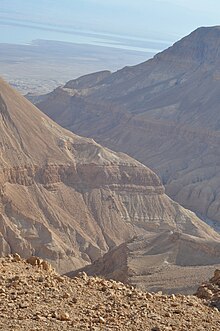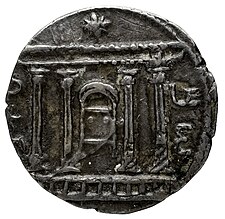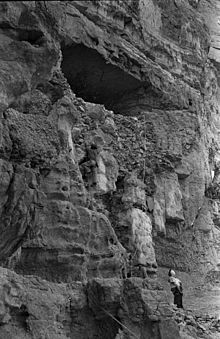Bar Kokhba refuge caves

 |
| Part of a series on the |
| Bar Kokhba revolt |
|---|
Bar Kokhba refuge caves are natural caves used for shelter by Jewish refugees during the later phases of the Bar Kokhba revolt. Most of the refuge caves were located in the Judaean Desert, nestled within steep cliffs far away from settlements, many overlooking the Dead Sea and the Jordan Valley. Some were also found in ravines flowing into the Dead Sea, while others were nestled within the Judaean Mountains.[1] Unlike the other two hideout systems used by the rebels, the purpose-built hiding complexes, and the hard-to-reach cliff shelters which often contain hewn installations, the refuge caves remained largely untouched by human intervention.[1][2]
Jews taking shelter in refuge caves aimed to escape the Roman army during its suppression of the revolt. Some caves show signs of successful refuge, while others contain skeletal remains of adults and children, indicating deaths due to starvation, thirst, or encounters with Roman forces.[1]
Refuge caves such as the Cave of Letters and Cave of Horror in Nahal Hever, as well as those within Wadi Murabba'at, have yielded many notable archaeological artifacts, including fragments of Biblical scrolls, documents in Aramaic and Greek, weaponry, and coins minted by the Bar Kokhba administration. The caves have also preserved artifacts of daily life, such as metalwork, pottery, glassware, and textiles, offering insights into life during this period and the experiences of the refugees.[3] One notable discovery includes letters written by Simon bar Kokhba himself, addressed to members of his administration.[4]
Older refuge caves[edit]
Caves were used for refuge throughout history in the region. Here a few examples long preceding the Bar Kokhba revolt.
Up the southern slope of the Masada cliff, the almost inaccessible Yoram Cave, whose only opening is located some 4 m above an exposed access path and 100 m below the plateau, has been found to contain 6,000-year-old barley seeds. The researchers think it was a place of short-term refuge for Chalcolithic people fleeing an unknown catastrophe and carrying with them the grain into the desert, the closest place where the barley could have been grown being at least 20 kilometers (12 miles) away.[5][6][7]
A refuge cave from Western Galilee, the Kamon Cave, was found to hold large storage jars as well as valuables, placed there at the end of the 4th century BCE during the Diadochi Wars, which have wrought havoc in the region including the destruction of nearby Acre.[8]
Examples[edit]
Until recently, the vast majority of the hideout systems datable to the Bar Kokhba revolt ( hiding complexes, cliff shelters, and refuge caves) were documented in what in biblical terms is termed as the territory of Judah.[2] More recently, such caves were discovered north of it, in Benjamin and Samaria.[2] In Galilee however, only the first two types of hideouts are known with certainty, with no refuge caves reported or published until 2018.[2] At that point however, from among the 136 caves surveyed in the Meiron Valley area of Upper Galilee, three or possibly four have yielded some pottery most likely dating from the 2nd-4th centuries (Late Roman period).[2] Due to the scarcity of the findings, researchers are not yet able to identify the population which hid in the caves, or the historical events which forced them to hide underground.[2] What these three caves have in common is that they are only accessible with the help of ropes, are not suitable for long-term habitation, and contain no installations.[2] Research needs to be continued.[2]
Wadi Muraba'at caves[edit]
Wadi Murabba'at or Nahal Darga, is a ravine in the northern Judean Desert housing three karstic refuge caves. Excavated in 1952 by Gerald Lankester Harding and Roland de Vaux, the caves yielded textiles, basketry, ropes, and fragments of leather and papyrus inscribed in Aramaic, Hebrew, and Greek. Among the discoveries were biblical texts, a marriage contract, and letters sent by Simon bar Kokhba.[9] A Minor Prophets scroll was found in a small crevice there by a Bedouin a few years later, in 1955.[10]
Cave of Letters[edit]

The Cave of Letters is located in the northern cliff of Nahal Hever in the Judaean Desert. In 1960, artifacts dating back to the Bar Kokhba revolt were discovered here by Yigael Yadin. Among the findings were skeletal remains of several families, garments, vessels, the archive of Babatha – featuring the documents of a upper-middle class woman – and a collection of letters in Hebrew and Aramaic written by Simon bar Kokhba to the leaders of Ein Gedi, namely, Yehonatan ben Be'ayah and Masabala ben Shimon.
Cave of Horror[edit]
Situated on the southern flank of Nahal Hever, close to the Dead Sea, the Cave of Horror gained its name from the discoveries made during excavations in 1955. Among the findings were multiple skeletons of women and children, alongside everyday objects and remnants of food. A subsequent excavation in 1961 unearthed fragments of a fragmented Minor Prophets Scroll in Greek.[4]
Te'omim cave[edit]
The Te'omim Cave, or Twins Cave, located in the western Jerusalem Mountains near Beit Shemesh, is significant for being one of the earliest refuge caves discovered outside the Judean Desert, within the Judean Mountains—the epicenter of the Bar Kokhba revolt. Excavations revealed skeletal remains of rebels, along with three hoards of coins, including a substantial number of Bar Kokhba coins, likely belonging to three different families. Additionally, two weapons, including a locally made spear, were found, concealed yet readily available for immediate use.[11]
El-Jai cave[edit]
The El-Jai cave is located in Nahal Michmas/Wadi es-Suweinit[12] (see Michmas), in the northern Judaean Desert.[13] In 1997, Eshel and Zissu found 16 coins there, including four minted by the Bar Kokhba administration.[13]
'Aboud cave[edit]
The 'Aboud Cave, situated in the western Benjamin Hills near the modern village of 'Aboud, lies within the eastern-central region of the West Bank. Explored by Boaz Zissu, Boaz Langford, and Amos Frumkin, the site yielded artifacts such as oil lamps, metalwork, glassware, and Bar Kokhba coinage.[14][15]
Other caves[edit]
Other caves include the Nahal Michmas cave, el-Misya, the Nahal Se'elim cave,[16] 'Araq el-Battan in Nahal Shiloh, Cave of the Spear, the Nahal 'Arugot cave, the Nahal Qidron cave, the Har Yishai cave (Ein Gedi atea),[16] the Nahal David caves,[16] the Pool Cave in Nahal David, and the Wadi el-Makkuk (Nahal Makuk) caves.
See also[edit]
References[edit]
- ^ a b c Eshel, Hanan (2019). "The Refuge Caves". The Bar Kokhba Revolt: The Archaeological Evidence. Jerusalem: Yad Izhak Ben-Zvi. pp. 62–64. ISBN 978-965-217-429-1.
- ^ a b c d e f g h Cite journal |last= Shivtiel |first= Yinon |last2= Osband |first2= Mechael |title= The Meiron Valley Cave Survey and the Use of Karstic Caves for Refuge in the Roman Period |year= 2018 |journal= In the Highland's Depth |publisher=Ariel University Press |volume= 8 |pages= 27-55 |issn= 2308-247X |doi= 10.26351/ITHD/8/14 |url= https://www.ariel.ac.il/wp/ihd/wp-content/uploads/sites/140/2019/02/Hilands-Depth-2018-ENGCode9-NET14.pdf |access-date= 3 May 2024}}
- ^ Zissu, Boaz; Eshel, Hanan (2016-01-01), "Religious Aspects of the Bar Kokhba Revolt: The Founding of Aelia Capitolina on the Ruins of Jerusalem", The Religious Aspects of War in the Ancient Near East, Greece, and Rome, Brill, p. 389, ISBN 978-90-04-32476-3, retrieved 2024-05-02
- ^ a b Schiffman, Lawrence W.; VanderKam, James C. (2000). "Preface". Encyclopedia of the Dead Sea Scrolls (1st ed.). Oxford University Press. pp. ix. ISBN 0-19-508450-0.
- ^ BIU spokesman (19 July 2016). "Genome of 6,000-year-old barley grains sequenced for first time". Bar-Ilan in the Press. Bar-Ilan University. Retrieved 12 August 2016.
- ^ "Domestication of barley began in northern Israel, 6000-year-old grains reveal". Ido Efrati for Haaretz. 19 July 2016. Retrieved 12 August 2016.
- ^ Ilan Ben Zion (18 July 2016). "6 millennia old but 'almost fresh,' Masada seeds unravel barley's origins". The Times of Israel. Retrieved 12 August 2016.
- ^ Klein, Eitan; Ganor, Amir; Distelfeld, Nir; Langford, Boaz; Ullman, Micka; Porat, Roi; Frumkin, Amos (2023). "The Kamon Cave Survey: A Refuge Cave from the Time of the Wars of the Diadochi". 'Atiqot (112): 251–277. Retrieved 3 May 2024.
- ^ Vaux, Father Roland de (2009-01-01), "Chapter 3: Discoveries at Wadi Murabba'at", The Dead Sea Scrolls, A Full History, Brill, pp. 115–129, doi:10.1163/9789004193741_004, ISBN 978-90-04-19374-1, retrieved 2024-05-02
- ^ Eshel, H. (2010). Gleaning of scrolls from the Judean Desert. In The Dead Sea Scrolls (pp. 47-87). Brill.
- ^ Zissu, Boaz; Eshel, Hanan; Langford, Boaz; Frumkin, Amos (2010). "Coins from the Bar Kokhba Revolt, hidden in Mearat Ha-Teomim (Mughâret Umm et Tûeimîn), Western Jerusalem Hills". Israel Numismatic Journal (17): 113–147.
- ^ Hofman, Miriam Ben Zeev (2019). "Eusebius and Hadrian's Founding of Aelia Capitolina in Jerusalem". Electrum. 26: 120. doi:10.4467/20800909el.19.007.11210. ISSN 1897-3426.
- ^ a b Zissu, Boaz; Eshel, Hanan (2016-01-01), "Religious Aspects of the Bar Kokhba Revolt: The Founding of Aelia Capitolina on the Ruins of Jerusalem", The Religious Aspects of War in the Ancient Near East, Greece, and Rome, Brill, pp. 389–393, ISBN 978-90-04-32476-3, retrieved 2024-05-02
- ^ Jackson-Tal, Ruth E.; Raviv, Dvir; Langford, Boaz; Davidovich, Uri; Frumkin, A.; Porat, Roi; Zissu, Boaz (2020). "Glass Use as a Reflection of Abandonment Processes: The 'Abud Refuge Cave, Roman Judea (133/134 C.E.)". Journal of Glass Studies. 62: 69–82. ISSN 0075-4250. JSTOR 26951073.
- ^ Zisu, Boaz; Langford, Boaz; Porat, Roi; Raviv, Dvir; Frumkin, Amos (2017). "מערת עבוד בימי מרידות היהודים ברומאים - תובנות חדשות לאור ממצאים חדשים וניתוח הממצא הקרמי ['Aboud Cave during the Jewish revolts against Rome: new insights in the light of new findings and the analysis of the ceramic findings]". In Tavger, Aharon; Amar, Zohar (eds.). במעבה ההר [In the Highland's Depth] (in Hebrew). Vol. 7. Ariel University and Hari Gofna Midrash. pp. 172–173. ISBN 978-965-91808-0-6.
- ^ a b c Porat, Roi; Eshel, Hanan; Frumkin, Amos (2007). "Finds from the Bar Kokhba Revolt from Two Caves at En Gedi". Palestine Exploration Quarterly. 139 (1): 35–53. doi:10.1179/003103207x163004. ISSN 0031-0328.
